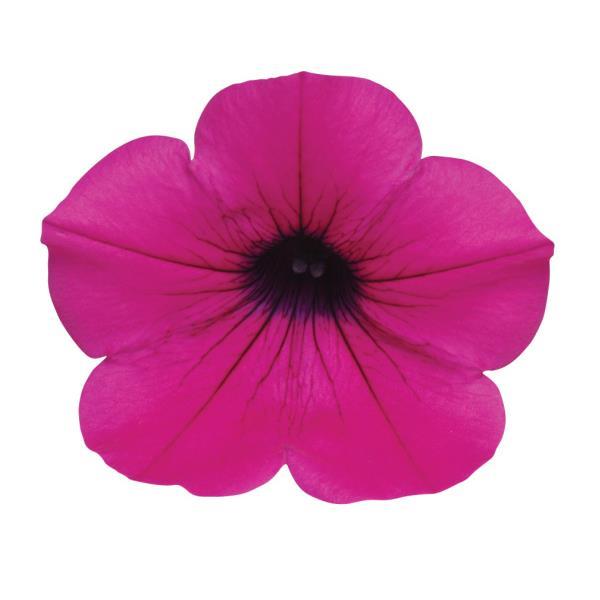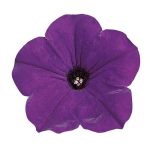Petunia, Wave Purple
Price range: $2.49 through $7.99
Discount per quantity
| Quantity | 3 - 8 | 9 - 14 | 15+ |
|---|---|---|---|
| Price | Price range: $2.42 through $7.75 | Price range: $2.34 through $7.51 | Price range: $2.24 through $7.19 |
| % Discount | 3% | 6% | 10% |
Description
Meet Wave Purple Petunia
Petunia Wave Purple is more than a flower. It is a living splash of royal color that spreads, trails, and cheers up every space it touches. When you plant Wave Purple, you invite months of unstoppable bloom. In containers, baskets, or garden beds, the velvety purple petals pour over edges and weave through companions. We are going to explore this rising star in detail, so you can grow it with confidence and joy.
Why Wave Purple Steals the Show
Wave petunias changed the petunia world by adding vigorous spreading power. Wave Purple lifts that legacy even higher. Flowers blanket the foliage, hiding most leaves in a sea of bold purple. Each bloom measures about two inches across. The color leans toward true violet, but in afternoon light it can glow with magenta highlights. The plant forms a low mound only 6–8 inches tall, yet the stems race outward up to 3 feet. In other words, you get a floral carpet without heavy upkeep.
Built for Long Seasons
- Heat Tolerance: Wave Purple keeps blooming through hot, muggy days.
- Rain Resilience: After storms, spent flowers shed quickly, making room for fresh ones.
- Self-Cleaning Habit: You rarely need to deadhead. New buds keep pushing forward.
A Rainbow in Purple Clothes
Even though we focus on purple here, Wave varieties include many colors. Growing Wave Purple next to pink, white, or silver foliage plants creates drama. The single-color mass also works when you want a bold, unified look.
A Short Tale of the Wave Series
Petunias first traveled from South America to European gardens in the 1800s. Breeders saw potential for wider shapes and brighter colors. After more than a century of gradual change, Japanese breeders introduced the “Wave” line in the mid-1990s. Their goal was clear: longer blooming, stronger spreading, and less work for gardeners. Wave Purple joined soon after the debut and quickly became a favorite for baskets, window boxes, and sweeping groundcovers.
Landscape Magic: Using Wave Purple
Container Cascades
Plant three starts in a 12-inch hanging basket. Within weeks, a dome of purple covers the pot. Add a trailing lime green sweet potato vine for contrast, and you have instant patio sparkle.
Garden Edging
Line walkways with Wave Purple at 12-inch spacing. The plants grow together, softening hard edges with flowing color. Visitors feel welcomed by the living border.
Living Mulch in Veggie Beds
Under taller tomatoes or peppers, Wave Purple shades soil, blocks weeds, and invites pollinators. Instead of bare ground, you harvest beauty.
Pollinator Playground
Bees and butterflies read the deep purple petals like neon signs. By including Wave Purple, you feed local beneficial insects. But most of all, you create a lively, buzzing, colorful scene.
Getting Started
Picking Strong Plants or Seeds
You can begin with seed packets or young transplants. Seeds give you many plants for low cost, yet they need 10–12 weeks indoors before the last frost. Transplants jump straight to the garden after danger of frost has passed. Choose sturdy seedlings with many branches and unopened buds. Avoid tall, floppy starts.
Ideal Location
Wave Purple loves full sun—at least six hours daily. More sun equals more blooms. Partial shade slows the show. Good air flow reduces disease, so avoid tight corners. Well-drained soil that holds some moisture keeps roots happy. Heavy clay can work if you lighten it with compost. Raised beds and large containers are safe bets when native soil stays soggy.
Planting Wave Purple
- Prepare the Site
Loosen soil 8 inches deep. Mix in 2–3 inches of aged compost. Balanced organic fertilizer—about 3-4-3—sets the stage for steady growth. - Dig Holes
Space holes 12 inches apart in garden beds. In baskets or planters, give each plant at least 10 inches of surface room. - Plant Gently
Remove the pot, keeping the root ball intact. Place roots level with the soil surface. Firm lightly. - Water Well
Soak the soil until water drains from the container bottom or the bed looks evenly moist. This first drink removes air pockets. - Mulch Lightly
A thin layer of straw or fine bark keeps soil cool and slows evaporation. Keep mulch an inch away from stems.
Instead of rushing, take your time with these steps. A calm start leads to a season of success.
Everyday Care
Watering Wisdom
Wave Purple needs steady moisture but hates soggy feet. In ground, one inch of water per week is a good target, more during high heat. Containers dry out faster; check daily. Stick your finger an inch into the soil. If dry, water until liquid runs out the drainage holes. Morning watering lets leaves dry quickly, lowering disease risk.
Feeding for Endless Blooms
Fast growth demands food. Use a water-soluble bloom booster every two weeks. If you prefer organic, a fish-based liquid or a top-dressing of worm castings works well. Slow-release fertilizer pellets in early summer can back you up during vacations.
Pinching and Pruning
Wave Purple normally self-cleans. Yet midsummer runners may thin in the center. Trim long stems by one-third to encourage fresh branching. Within a week, new shoots fill gaps and revive the mound.
Keeping Leaves Healthy
Splashing soil can spread diseases like petunia blight. Mulch and drip irrigation reduce splatter. In humid regions, a monthly spray of compost tea builds leaf resilience. Proper spacing and sun keep foliage dry and strong.
Troubleshooting Pests and Problems
| Issue | Symptoms | Simple Fix |
|---|---|---|
| Aphids | Sticky leaves, tiny green bugs | Spray with sharp water jet; follow with insecticidal soap |
| Caterpillars | Ragged holes | Hand-pick at dusk; invite birds with a birdbath |
| Powdery Mildew | White film on leaves | Improve airflow, apply neem oil after sunset |
| Root Rot | Wilting despite wet soil | Improve drainage, replant into raised bed or new pot |
In other words, most troubles fade when you balance sun, water, and airflow.
Seasonal Care Guide
Spring
- Start Indoors: Sow seeds 10 weeks before last frost.
- Harden Off: Move seedlings outside for a few hours each day during the final week of frost season.
Summer
- Feed Regularly: Bloom boosters keep color strong.
- Trim Lightly: Shape plants after big flushes of flowers.
Autumn
- Enjoy the Encore: Wave Purple keeps flowering until a hard frost.
- Collect Seeds (Optional): Most hybrids will not breed true, but it is fun to try.
After more than one season, you will know your local rhythm.
Propagation for the Curious
Wave Purple is most often grown from seed, but soft-tip cuttings root in water or moist vermiculite. Snip a 4-inch non-flowering shoot, remove lower leaves, and place it in bright indirect light. Roots appear in 10 days. Pot up when roots are an inch long. This method copies the parent exactly.
Companion Planting Ideas
- Edibles: Tomatoes, peppers, and basil all pair well. Wave Purple attracts pollinators and shades soil.
- Ornamentals: Combine with silver dusty miller, gold marigolds, or trailing white alyssum.
- Native Friends: Near coneflowers and black-eyed Susans, Wave Purple fills gaps and boosts color contrast.
Instead of planting alone, think of your garden as a team sport. Diversity leads to balance.
Eco-Friendly Notes
Wave Purple supports bees and butterflies with nectar. Because the plant spreads, it covers soil and cuts down on weed pressure, letting you skip herbicides. Using organic fertilizers and hand watering in the morning saves beneficial insects. When the season ends, compost the plant bodies to feed next year’s soil.
Creative Uses Indoors and Out
- Petal Ice Cubes: Freeze washed blooms in ice for party drinks.
- Pressed Flower Art: Flatten petals in a book between parchment. Frame the results.
- Living Wall Pocket: Tuck Wave Purple starts into fabric wall planters for a blooming mural.
- Fairy Garden Accent: A single tiny transplant fills miniature landscapes with real color.
These playful projects turn gardening into year-round fun.
Common Questions
Do I need to deadhead Wave Purple?
Not usually. The plant drops spent blooms on its own.
Why are leaves yellowing?
Over-watering or lack of nitrogen. Let soil dry slightly and feed with balanced fertilizer.
Can I overwinter it indoors?
Wave Purple is tender. Most people treat it as an annual. You can try rooting cuttings and growing them under lights, but new seeds or plants next spring are easier.
Growing Together: A Last Word of Blossoms
Wave Purple petunia invites us into an easy partnership. We give sunlight, water, and a bit of food. In return, the plant offers months of rich purple waves that move with the breeze and light up our days. Whether you garden on a balcony or across acres, this lively spreader finds a place in your plan. Embrace its vigor, share cuttings with friends, and watch the season unfold in purple joy.
Petal-Bright Farewell Symphony
Additional information
| Weight | N/A |
|---|---|
| Options | Seed 10 count, Starter Plug – 3 count, 4 in. (16.9 fl. oz.) Pot |





